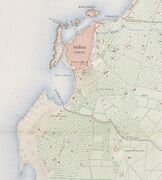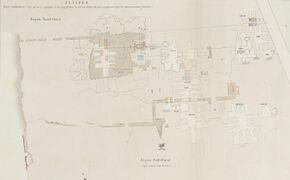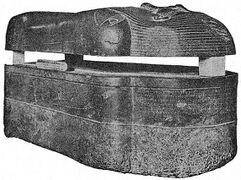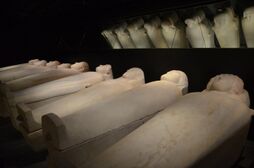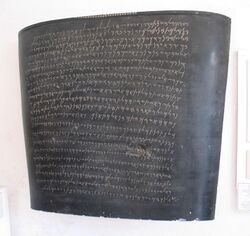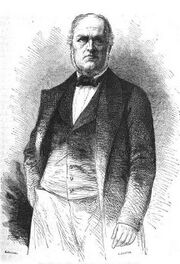Social:Eshmunazar II sarcophagus
| Eshmunazar II sarcophagus | |
|---|---|
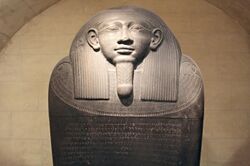 Closeup of the sarcophagus lid. | |
| Material | Amphibolite |
| Long | 2.56 m (8.4 ft) |
| Height | 1.19 m (3.9 ft) |
| Width | 1.25 m (4.1 ft) |
| Writing | Phoenician language |
| Created | 6th-century BC |
| Period/culture | Achaemenid Phoenicia |
| Discovered | 19 January 1855 Magahret Abloun [Cavern of Apollo], Sidon, modern-day Lebanon [ ⚑ ] : 33°33′04″N 35°22′26″E / 33.551°N 35.374°E |
| Discovered by | Alphonse Durighello |
| Present location | The Louvre, Paris |
| Identification | AO 4806 |
| Language | Phoenician |
| Period | Achaemenid era |
| Culture | Phoenician |
The Eshmunazar II sarcophagus is a 6th-century BC sarcophagus unearthed in 1855 in the "Phoenician Necropolis", a hypogeum (underground tomb) complex in the southern area of the city of Sidon in modern-day Lebanon. The sarcophagus was discovered by members of the French consulate in Sidon and was donated to the Louvre. The Eshmunazar II sarcophagus has two sets of Phoenician inscriptions, one on its lid and the other on its trough, under the sarcophagus head. The lid engraving was of great significance upon its discovery; it was the first Phoenician language inscription to be discovered in Phoenicia proper, the most detailed Phoenician text ever found anywhere up to that point, and is today the second longest extant Phoenician inscription after the one discovered at Karatepe.
Eshmunazar II (Phoenician: 𐤀𐤔𐤌𐤍𐤏𐤆𐤓 Script error: The function "transl" does not exist., a theophoric name meaning 'Eshmun helps') was a Phoenician King of Sidon and the son of King Tabnit. His sarcophagus was likely carved in Egypt from local amphibolite, and captured as booty by the Sidonians during their participation in Cambyses II's conquest of Egypt in 525 BC.
More than a dozen scholars across Europe and the United States rushed to translate the sarcophagus inscriptions. French orientalist Jean-Joseph-Léandre Bargès noted the similarities between the Phoenician language and Hebrew. The translation allowed scholars to identify the king buried inside, his lineage, and construction feats. The inscriptions warn readers against disturbing Eshmunazar II's place of repose; they also recount that the "Lord of Kings", the Achaemenid king, granted Eshmunazar II the territories of Dor, Joppa, and Dagon in recognition for his services.
The discovery led to great enthusiasm for archaeological research in the region, and was the primary catalyst for Ernest Renan's 1860-61 Mission de Phénicie, the first major archaeological mission to Lebanon and Syria.[1]
Eshmunazar II
Eshmunazar II (Phoenician:𐤀𐤔𐤌𐤍𐤏𐤆𐤓 Script error: The function "transl" does not exist., a theophoric name meaning 'Eshmun helps') was a Phoenician King of Sidon (r. c. 539 – c. 525 BC), the grandson of king Eshmunazar I, and a vassal king of the Achaemenid Empire. Eshmunazar II reigned after his father Tabnit I on the throne of Sidon, and died at the premature age of 14, whereafter he was succeeded by his cousin Bodashtart.[2][3]
Discovery
The discovery of the sarcophagus of Eshmunazar II was announced on 11 February 1855 in The Journal of Commerce. According to the paper, the hypogeum (underground tomb) containing the sarcophagus was discovered on 19 January 1855 when treasure-hunters were digging in the grounds of an ancient cemetery in the plains south of the city of Sidon, in modern-day Lebanon.[4]
On 20 February 1855, Antoine-Aimé Peretié, the chancellor of the French consulate in Beirut and amateur archaeologist was informed by Alphonse Durighello, an agent of the French consulate in Sidon, of an archaeological find in a hollowed-out rocky mound that was known to locals as Magharet Abloun 'The Cavern of Apollo'.[5][6][7][8] Durighello had taken advantage of the absence of laws governing archaeological excavation and the disposition of the finds under the Ottoman rule over Lebanon and had been involved in the lucrative business of digging up and trafficking archaeological artifacts. Under the Ottomans, it sufficed to either own the land or to have the owner's permission to excavate. Any finds resulting from the digs became the property of the finder.[9] To perform digs in the site of the cavern, Durighello bought the exclusive right from the land owner, the then Mufti of Sidon Mustapha Effendi.[9][10] Durighello, who is referred to as Peretié's "agent" in de Luynes' account, unearthed a sarcophagus of black amphibolite in an underground vaulted hypogeum and sold it to Peretié.[5][6][10][11]
Magharet Abloun was part of one of the royal necropolises of Achaemenid period Sidon; these consist of clusters of rock cut subterranean burial chambers accessible through vertical shafts.[7] The hypogeum contains four rock-cut niches at the ground level the largest of which measures around 2 m (6.6 ft) wide and deep; the other niches measure around 1 m (3.3 ft) in width and are of the same depth. On the opposite cavern wall are two niches of smaller dimensions; next these lies the entrance to the main burial chamber where two steps are cut into the rock and lead to the point where the head of the main sarcophagus was located.[5][6]
The sarcophagus of Eshmunazar II was discovered just outside of the Magharet Abloun mound; it was protected by a vault of which some stones still remain in place. One tooth, a piece of bone, and a human jaw were found in the rubble during the sarcophagus extraction.[5]
Description
The Egyptian anthropoid-style sarcophagus dates to the 6th-century BC,[12] it is made of a solid, well polished block of bluish-black amphibolite.[6][13] It measures 256 cm (8.40 ft) long, 125 cm (4.10 ft) wide, and 119 cm (3.90 ft) high.[note 1][7]
The lid displays a relief carving of the figure of a deceased person in the style of the Egyptian mummy sarcophagi.[13] The effigy of the deceased is portrayed as smiling,[15] wrapped up to its neck in a thick shroud leaving the head uncovered. The effigy is dressed with a large Nubian wig, a false braided beard, and an Usekh collar ending with falcon heads at each of its extremities as is often seen at the neck of Egyptian mummies.[7][5][15]
Two other sarcophagi of the same style were also unearthed in the Sidon necropolis.[16]
Origin and dating of the sarcophagus
The Egyptian-style sarcophagi found in Sidon were originally made in Egypt for members of the Ancient Egyptian elite, but were then transported to Sidon and repurposed for the burial of Sidonian kings. The manufacture of this style of sarcophagi in Egypt ceased around 525 BC with the fall of the 26th dynasty.[17][18][19] The sarcophagi are believed to have been captured as booty by the Sidonians during their participation in Cambyses II's conquest of Egypt in 525 BC. Herodotus recounts an event in which Cambyses II "ransacked a burial ground at Memphis, where coffins were opened up and the dead bodies they contained were examined", quite possibly providing the occasion on which the sarcophagi were removed and reappropriated by his Sidonian subjects.[20][17][18][19][21]
Whereas the Tabnit sarcophagus, belonging to the father of Eshmunazar II, reemployed a sarcophagus already dedicated on its front with a long Egyptian inscription in the name of an Egyptian general, the sarcophagus used for Eshmunazar II was new and was inscribed with a full-length dedication in Phoenician on a clean surface. According to French archaeologist and epigrapher René Dussaud, the sarcophagus may have been ordered by his surviving mother, Queen Amoashtart, who arranged for the inscription to be made.[22]
These sarcophagi (a third one probably belonged to the Queen Amoashtart), are the only Egyptian sarcophagi that have ever been found outside of Egypt proper.[23]
Stylistic impact on local sarcophagi
Inscriptions
The Egyptian-style sarcophagus was free from hieroglyphs, but it had 22 lines of 40 to 55 letters each of Phoenician text on its lid instead.[5][24] The lid inscriptions occupy a square situated under the sarcophagus' Usekh collar and measure 84 cm (2.76 ft) in length and width.[14][13] A second inscription carved in more delicate and uniformly carved Phoenician characters than the first was found around the curvature of the head on the trough of the sarcophagus. It measures 140 cm (4.6 ft) in length and consists of six lines and a fragment of a seventh line.[14][25][26] As is customary for Phoenician writing, all the characters are written without spaces separating each word except for a space in line 13 of the lid inscription which divides the text in two equal parts.[26] The letters are not evenly distanced ranging from no distance to a spacing of 6.35 mm (0.250 in). The lines of the text are not straight and not evenly spaced. The letters in the lower part of the text (after the lacuna on line 13) is neater and smaller than the letters of the first part of the inscription.[27]
The sarcophagus trough inscriptions correspond in size and style to the letters of the second part of the lid inscriptions. The letters are carved close together on the sixth line and the text breaks off on the seventh line, consisting of nine characters which form the beginning of the text that begins after the lacuna on the 13th line of the sarcophagus lid inscription.[27] De Luynes and Turner believe that the inscription was free-hand traced directly on the stone without the use of typographic guides for letter-spacing and that these traces were followed by the carving artisan. The letters of the first three lines of the lid inscription are cut deeper and rougher than the rest of the text which indicates that the sculptor was either replaced or made to work more neatly.[27]
The external surface of the sarcophagus trough bears an isolated group of two Phoenician characters. De Luynes believes that they may have been trial carving marks made by the engraver of the inscription.[28]
The inscriptions of the sarcophagus of Eshmunazar are known to scholars as CIS I 3 and KAI 14; they are written in the Phoenician Canaanite language, in the Phoenician alphabet. They identify the king buried inside, tell of his lineage and temple construction feats and warns against disturbing him in his repose.[29] The inscriptions also state that the "Lord of Kings" (the Achaemenid King of Kings) granted the Sidonian king "Dor and Joppa, the mighty lands of Dagon, which are in the plain of Sharon" in recognition of his deeds.[29] The lid inscription is the second longest extant Phoenician inscription after the Karatepe bilingual,[30] and according to Gibson it "offers an unusually high proportion of literary parallels with the Hebrew Bible, especially its poetic sections".[25]
As in other Phoenician inscriptions, the text seems to use no, or hardly any, matres lectionis, the letters that indicate vowels in Semitic languages. As in Aramaic, the preposition אית (ʾyt) is used as an accusative marker, while את (ʾt) is used for "with".[31]
Translations
Copies of the inscriptions were sent to scholars across the world.[32] Translations of the Eshmunazar II sarcophagus inscriptions were published by well known scholars (see below table).[33] Several other well known scholars worked on the translation, including the polymath Josiah Willard Gibbs, Hebrew language scholar William Henry Green, Biblical scholars James Murdock and Williams Jenks, and Syriac language expert Christian Frederic Crusé.[34] American missionaries William McClure Thomson and Eli Smith were living in Ottoman Syria at the time of the discovery of the sarcophagus and had successfully translated most of the inscription by early 1855, but did not produce any publications.[34]
Belgian semitist Jean-Claude Haelewyck provided a hypothetical vocalization of the Phoenician text. A definitive vocalization is not possible because Phoenician is written without matres lectionis. Haelewyck based the premise of his vocalization on the affinity of the Phoenician and Hebrew languages, historical grammar and ancient transcriptions.[35]
A list of early published translations is below:[33]
| Author | Memoir | Previous interpretations consulted | Published work |
|---|---|---|---|
| Edward E. Salisbury | Phoenician Inscription of Sidon[36] | ||
| William Wadden Turner | 3 July 1855 | The Sidon Inscription[37] | |
| Emil Rödiger | 15 June 1855 | Bemerkungen über die phönikische Inschrift eines am 19. Januar 1855 nahe bei Sidon gefundenen Königs-Sarkophag's[38] | |
| Franz Dietrich and Johann Gildemeister | 1 July 1855 | Zwei Sidonische Inschriften, eine griechische aus christlicher Zeit und eine altphönicische Königsinschrift[39] | |
| Ferdinand Hitzig | 30 September 1855 | Rödiger, Dietrich. | Die Grabschrift des Eschmunazar[40] |
| Konstantin Schlottmann | December 1855 | Rödiger, Dietrich, Hitzig, De Luynes and Ewald. | Die Inschrift Eschmunazar's, Königs der Sidonier[41] |
| Honoré Théodoric d'Albert de Luynes | 15 December 1855 | Mémoire sur le Sarcophage et inscription funéraire d'Esmunazar, roi de Sidon[42] | |
| Heinrich Ewald | 19 January 1856 | Salisbury, Turner, Roidiger, Dietrich, Hitzig. | Erklärung der grossen phönikischen inschrift von Sidon und einer ägyptisch-aramäischen : mit den zuverlässigen abbildern beider[43] |
| Jean-Joseph-Léandre Bargès | 1856 | Salisbury, Turner, Rödiger, Dietrich, Hitzig, De Luynes, Ewald (?). | Mémoire sur le sarcophage et l'inscription funéraire d'Eschmounazar, roi de Sidon[44] |
| Salomon Munk | 6 April 1856 | Salisbury, Turner, Rödiger, Dietrich, Hitzig, DeLuynes, Bargès. | Essais sur l'inscription phénicienne du sarcophage d'Eschmoun-'Ezer, roi de Sidon[45] |
| Moritz Abraham Levy | August 1856 | Salisbury, Turner, Rödiger, Dietrich, Hitzig, Ewald, De Luynes, Munk | Phönizisches Wörterbuch[46] |
English translation
| Line
number |
Original Phoenician Inscription | Transliteration | Transcription | English Translation |
|---|---|---|---|---|
| 1 | 𐤁𐤉𐤓𐤇 𐤁𐤋 𐤁𐤔𐤍𐤕 𐤏𐤎𐤓 𐤅𐤀𐤓𐤁𐤏 𐤗𐤖𐤖𐤖𐤖 𐤋𐤌𐤋𐤊𐤉 𐤌𐤋𐤊 𐤀𐤔𐤌𐤍𐤏𐤆𐤓 𐤌𐤋𐤊 𐤑𐤃𐤍𐤌
|
byrḥ bl bšnt ʿsr wʾrbʿ 14 lmlky mlk ʾšmnʿzr mlk ṣdnm | bīyīraḥ Būl bašant ʿasr waʾarbaʿ 14 lamūlkīyū mīlk ʾEšmūnʿazēr mīlk Ṣīdūnīm | In the month of Bul, in the fourteenth year of the reign of king Eshmunazar, king of the Sidonians |
| 2 | 𐤁𐤍 𐤌𐤋𐤊 𐤕𐤁𐤍𐤕 𐤌𐤋𐤊 𐤑𐤃𐤍𐤌 𐤃𐤁𐤓 𐤌𐤋𐤊 𐤀𐤔𐤌𐤍𐤏𐤆𐤓 𐤌𐤋𐤊 𐤑𐤃𐤍𐤌 𐤋𐤀𐤌𐤓 𐤍𐤂𐤆𐤋𐤕
|
bn mlk tbnt mlk ṣdnm dbr mlk ʾšmnʿzr mlk ṣdnm lʾmr ngzlt | bīn mīlk Tabnīt mīlk Ṣīdūnīm dōbōr mīlk ʾEšmūnʿazēr mīlk Ṣīdūnīm laʾamar nagzaltī | son of king Tabnit, king of the Sidonians, king Eshmunazar, king of the Sidonians, said as follows: I was carried away |
| 3 | 𐤁𐤋 𐤏𐤕𐤉 𐤁𐤍 𐤌𐤎𐤊 𐤉𐤌𐤌 𐤀𐤆𐤓𐤌 𐤉𐤕𐤌 𐤁𐤍 𐤀𐤋𐤌𐤕 𐤅𐤔𐤊𐤁 𐤀𐤍𐤊 𐤁𐤇𐤋𐤕 𐤆 𐤅𐤁𐤒𐤁𐤓 𐤆
|
bl ʿty bn msk ymm ʾzrm ytm bn ʾlmt wškb ʾnk bḥlt z wbqbr z | bīlō ʿōtīya bīn masōk yōmīm ʾazīrīm yatūm bīn ʾalmat wašūkēb ʾanōk(ī) bīḥalōt ze wabīqabr ze | before my time, son of a limited number of short days (or: son of a limited number of days I was cut off), an orphan, the son of a widow, and I am lying in this coffin and in this tomb, |
| 4 | 𐤁𐤌𐤒𐤌 𐤀𐤔 𐤁𐤍𐤕 𐤒𐤍𐤌𐤉 𐤀𐤕 𐤊𐤋 𐤌𐤌𐤋𐤊𐤕 𐤅𐤊𐤋 𐤀𐤃𐤌 𐤀𐤋 𐤉𐤐𐤕𐤇 𐤀𐤉𐤕 𐤌𐤔𐤊𐤁 𐤆 𐤅
|
bmqm ʾš bnt qnmy ʾt kl mmlkt wkl ʾdm ʾl yptḥ ʾyt mškb z w | bīmaqōm ʾeš banītī qanūmīya ʾata kūl mamlōkūt wakūl ʾadōm ʾal yīptaḥ ʾīyat mīškōb ze wa- | in a place which I have built. Whoever you are, king or (ordinary) man, may he (sic!) not open this resting-place and |
| 5 | 𐤀𐤋 𐤉𐤁𐤒𐤔 𐤁𐤍 𐤌𐤍𐤌 𐤊 𐤀𐤉 𐤔𐤌 𐤁𐤍 𐤌𐤍𐤌 𐤅𐤀𐤋 𐤉𐤔𐤀 𐤀𐤉𐤕 𐤇𐤋𐤕 𐤌𐤔𐤊𐤁𐤉 𐤅𐤀𐤋 𐤉𐤏𐤌
|
ʾl ybqš bn mnm k ʾy šm bn mnm wʾl yšʾ ʾyt ḥlt mškby wʾl yʿm | -ʾal yebaqēš bīnū mīnūma kī ʾīy waʾal yīšōʾ ḥalōt mīškōbī waʾal yaʿmū- | may he not search in it after anything because nothing whatsoever has been placed into it. And may he not move the coffin of my resting-place, nor carry me |
| 6 | 𐤎𐤍 𐤁𐤌𐤔𐤊𐤁 𐤆 𐤏𐤋𐤕 𐤌𐤔𐤊𐤁 𐤔𐤍𐤉 𐤀𐤐 𐤀𐤌 𐤀𐤃𐤌𐤌 𐤉𐤃𐤁𐤓𐤍𐤊 𐤀𐤋 𐤕𐤔𐤌𐤏 𐤁𐤃𐤍𐤌 𐤊 𐤊𐤋 𐤌𐤌𐤋𐤊𐤕 𐤅
|
sn bmškb z ʿlt mškb šny ʾp ʾm ʾdmm ydbrnk ʾl tšmʿ bdnm k kl mmlkt w | -sēnī bīmīškōb ze ʿalōt mīškōb šenī ʾap ʾīm ʾadōmīm yīdbrūnakō ʾal tīšmaʿ badanōm kī kūl mamlōkūt wa- | away from this resting-place to another resting-place. Also if men talk to you do not listen to their chatter. For every king and |
| 7 | 𐤊𐤋 𐤀𐤃𐤌 𐤀𐤔 𐤉𐤐𐤕𐤇 𐤏𐤋𐤕 𐤌𐤔𐤊𐤁 𐤆 𐤀𐤌 𐤀𐤔 𐤉𐤔𐤀 𐤀𐤉𐤕 𐤇𐤋𐤕 𐤌𐤔𐤊𐤁𐤉 𐤀𐤌 𐤀𐤔 𐤉𐤏𐤌𐤎𐤍 𐤁𐤌
|
kl ʾdm ʾš yptḥ ʿlt mškb z ʾm ʾš yšʾ ʾyt ḥlt mškby ʾm ʾš yʿmsn bm | -kūl ʾadōm ʾīš yīptaḥ ʿalōt mīškōb ʾīm ʾīš yīšōʾ ʾīyat ḥalōt mīškōb ʾīm ʾīš yaʿmūšēnī bīmī- | every (ordinary) man, who will open what is above this resting-place, or will lift up the coffin of my resting-place, or will carry me away from |
| 8 | 𐤔𐤊𐤁 𐤆 𐤀𐤋 𐤉𐤊𐤍 𐤋𐤌 𐤌𐤔𐤊𐤁 𐤀𐤕 𐤓𐤐𐤀𐤌 𐤅𐤀𐤋 𐤉𐤒𐤁𐤓 𐤁𐤒𐤁𐤓 𐤅𐤀𐤋 𐤉𐤊𐤍 𐤋𐤌 𐤁𐤍 𐤅𐤆𐤓𐤏
|
škb z ʾl ykn lm mškb ʾt rpʾm wʾl yqbr bqbr wʾl ykn lm bn wzrʿ | -škōb ze ʾal yakūn lam mīškōb ʾet Repaʾīm waʾal yīqōbērū bīqabr waʾal yakūn lam bīn wazeraʿ | this resting-place, may they not have a resting-place with the Rephaïm, may they not be buried in a tomb, and may they not have a son or offspring |
| 9 | 𐤕𐤇𐤕𐤍𐤌 𐤅𐤉𐤎𐤂𐤓𐤍𐤌 𐤄𐤀𐤋𐤍𐤌 𐤄𐤒𐤃𐤔𐤌 𐤀𐤕 𐤌𐤌𐤋𐤊(𐤕) 𐤀𐤃𐤓 𐤀𐤔 𐤌𐤔𐤋 𐤁𐤍𐤌 𐤋𐤒
|
tḥtnm wysgrnm hʾlnm hqdšm ʾt mmlk(t) ʾdr ʾš mšl bnm lq | taḥtenōm wayasgīrūnōm hāʾīlōnīm haqadōšīm ʾet mamlōkū(t) ʾadīr ʾīš mōšel bīnōm laqī- | after them. And may the sacred gods deliver them to a mighty king who will rule them in order |
| 10 | 𐤑𐤕𐤍𐤌 𐤀𐤉𐤕 𐤌𐤌𐤋𐤊𐤕 𐤀𐤌 𐤀𐤃𐤌 𐤄𐤀 𐤀𐤔 𐤉𐤐𐤕𐤇 𐤏𐤋𐤕 𐤌𐤔𐤊𐤁 𐤆 𐤀𐤌 𐤀𐤔 𐤉𐤔𐤀 𐤀𐤉𐤕
|
ṣtnm ʾyt mmlkt ʾm ʾdm hʾ ʾš yptḥ ʿlt mškb z ʾm ʾš yšʾ ʾyt | -ṣōtīnōm ʾīyat mamlōkūt ʾīm ʾīš ʾadōm hūʾa ʾīš yīptaḥ ʿalōt mīškōb ze ʾīm ʾīš yīšōʾ ʾīyat | to exterminate them, the king or this (ordinary) man who will open what is over this resting-place or will lift up |
| 11 | 𐤇𐤋𐤕 𐤆 𐤅𐤀𐤉𐤕 𐤆𐤓𐤏 𐤌𐤌𐤋𐤕 𐤄𐤀 𐤀𐤌 𐤀𐤃𐤌𐤌 𐤄𐤌𐤕 𐤀𐤋 𐤉𐤊𐤍 𐤋𐤌 𐤔𐤓𐤔 𐤋𐤌𐤈 𐤅
|
ḥlt z wʾyt zrʿ mmlt hʾ ʾm ʾdmm hmt ʾl ykn lm šrš lmṭ w | ḥalōt mīškōb ze waʾīyat zeraʿ mamlō[kū]t hūʾa ʾīm ʾīš ʾadōmīm hūmatū ʾal yakūn lam šūrš lamaṭō wa- | this coffin, and (also) the offspring of this king or of those (ordinary) men. They shall not have root below or |
| 12 | 𐤐𐤓 𐤋𐤌𐤏𐤋 𐤅𐤕𐤀𐤓 𐤁𐤇𐤉𐤌 𐤕𐤇𐤕 𐤔𐤌𐤔 𐤊 𐤀𐤍𐤊 𐤍𐤇𐤍 𐤍𐤂𐤆𐤋𐤕 𐤁𐤋 𐤏𐤕𐤉 𐤁𐤍 𐤌𐤎
|
pr lmʿl wtʾr bḥym tḥt šmš k ʾnk nḥn ngzlt bl ʿty bn ms | -pīr lamaʿlō watōʾar baḥayīm taḥat šamš kī ʾanōk(ī) nōḥōn nagzaltī bīlō ʿōtīya bīn masō- | fruit above or appearance in the life under the sun. For I who deserve mercy, I was carried away before my time, son of a limited |
| 13 | 𐤊 𐤉𐤌𐤌 𐤀𐤆𐤓𐤌 𐤉𐤕𐤌 𐤁𐤍 𐤀𐤋𐤌𐤕 𐤀𐤍𐤊 𐤊 𐤀𐤍𐤊 𐤀𐤔𐤌𐤍𐤏𐤆𐤓 𐤌𐤋𐤊 𐤑𐤃𐤍𐤌 𐤁𐤍
|
k ymm ʾzrm ytm bn ʾlmt ʾnk k ʾnk ʾšmnʿzr mlk ṣdnm bn | -k yōmīm ʾazīrīm yatūm bīn ʾalmat ʾanōk(ī) kī ʾanōk(ī) ʾEšmūnʿazēr mīlk Ṣīdūnīm bīn | number of short days (or: son of a limited number of days I was cut off), I an orphan, the son of a widow. For I, Eshmunazar, king of the Sidonians, son of |
| 14 | 𐤌𐤋𐤊 𐤕𐤁𐤍𐤕 𐤌𐤋𐤊 𐤑𐤃𐤍𐤌 𐤁𐤍 𐤁𐤍 𐤌𐤋𐤊 𐤀𐤔𐤌𐤍𐤏𐤆𐤓 𐤌𐤋𐤊 𐤑𐤃𐤍𐤌 𐤅𐤀𐤌𐤉 𐤀𐤌 𐤏𐤔𐤕𐤓𐤕
|
mlk tbnt mlk ṣdnm bn bn mlk ʾšmnʿzr mlk ṣdnm wʾmy ʾm ʿštrt | mīlk Tabnīt mīlk Ṣīdūnīm bīn bīn mīlk ʾEšmūnʿazēr mīlk Ṣīdūnīm waʾīmī ʾAmō[t]ʿaštart | king Tabnit, king of the Sidonians, grandson of king Eshmunazar, king of the Sidonians, and my mother Amo[t]astart, |
| 15 | 𐤊𐤄𐤍𐤕 𐤏𐤔𐤕𐤓𐤕 𐤓𐤁𐤕𐤍 𐤄𐤌𐤋𐤊𐤕 𐤁𐤕 𐤌𐤋𐤊 𐤀𐤔𐤌𐤍𐤏𐤆𐤓 𐤌𐤋𐤊 𐤑𐤃𐤍𐤌 𐤀𐤌 𐤁𐤍𐤍 𐤀𐤉𐤕 𐤁𐤕
|
khnt ʿštrt rbtn hmlkt bt mlk ʾšmnʿzr mlk ṣdnm ʾm bnn ʾyt bt | kōhant ʿAštart rabōtanū hamalkat bīt mīlk ʾEšmūnʿazēr mīlk Ṣīdūnīm ʾīm banīnū ʾīyat bēt | priestess of Ashtart, our lady, the queen, daughter of king Eshmunazar, king of the Sidonians, (it is we) who have built the temples |
| 16 | 𐤀𐤋𐤍𐤌 𐤀𐤉𐤕 (...)𐤕 𐤁𐤑𐤃𐤍 𐤀𐤓𐤑 𐤉𐤌 𐤅𐤉𐤔𐤓𐤍 𐤀𐤉𐤕 𐤏𐤔𐤕𐤓𐤕 𐤔𐤌𐤌 𐤀𐤃𐤓𐤌 𐤅𐤀𐤍𐤇𐤍
|
ʾlnm ʾyt (...)t bṣdn ʾrṣ ym wyšrn ʾyt ʿštrt šmm ʾdrm wʾnḥn | ʾīlōnīm ʾīyat [bēt ʿAštar]t bīṢīdūn ʾarṣ yam wayīšarnū ʾīyat ʿAštart šamēm ʾadīrīm waʾanaḥnū | of the gods, [the temple of Ashtar]t in Sidon, the land of the sea. And we have placed Ashtart (in) the mighty heavens (or: in Shamem-Addirim?). And it is we |
| 17 | 𐤀𐤔 𐤁𐤍𐤍 𐤁𐤕 𐤋𐤀𐤔𐤌𐤍 (?)𐤓 𐤒𐤃𐤔 𐤏𐤍𐤉𐤃𐤋𐤋 𐤁𐤄𐤓 𐤅𐤉𐤔𐤁𐤍𐤉 𐤔𐤌𐤌 𐤀𐤃𐤓𐤌 𐤅𐤀𐤍𐤇𐤍 𐤀𐤔 𐤁𐤍𐤍 𐤁𐤕𐤌
|
ʾš bnn bt lʾšmn (?)r qdš ʿnydll bhr wyšbny šmm ʾdrm wʾnḥn ʾš bnn btm | ʾaš banīnū bēt laʾEšmūn [ša]r qūdš ʿīnYDLL bīharī wayīšarnīyū šamēm ʾadīrīm waʾanaḥnū ʾīš banīnū bētīm | who have built a temple for Eshmun, the prince of the sanctuary of the source of Ydll in the mountains, and we have placed him (in) the mighty heavens (or: in Shamem-Addirim?). And it is we who have built temples |
| 18 | 𐤋𐤀𐤋𐤍 𐤑𐤃𐤍𐤌 𐤁𐤑𐤃𐤍 𐤀𐤓𐤑 𐤉𐤌 𐤁𐤕 𐤋𐤁𐤏𐤋 𐤑𐤃𐤍 𐤅𐤁𐤕 𐤋𐤏𐤔𐤕𐤓𐤕 𐤔𐤌 𐤁𐤏𐤋 𐤅𐤏𐤃 𐤉𐤕𐤍 𐤋𐤍 𐤀𐤃𐤍 𐤌𐤋𐤊𐤌
|
lʾln ṣdnm bṣdn ʾrṣ ym bt lbʿl ṣdn wbt lʿštrt šm bʿl wʿd ytn ln ʾdn mlkm | laʾīlōnē Ṣīdūnīm bīṢīdūn ʾarṣ yam bēt laBaʿl Ṣīdūn wabēt ʿAštart šīm Baʿl waʿad yatan lanū ʾadūn mīlkīm | for the gods of the Sidonians in Sidon, the land of the sea, a temple for Baal of Sidon, and a temple for Ashtart, the Name of Baal. Moreover, the lord of kings gave us |
| 19 | 𐤀𐤉𐤕 𐤃𐤀𐤓 𐤅𐤉𐤐𐤉 𐤀𐤓𐤑𐤕 𐤃𐤂𐤍 𐤄𐤀𐤃𐤓𐤕 𐤀𐤔 𐤁𐤔𐤃 𐤔𐤓𐤍 𐤋𐤌𐤃𐤕 𐤏𐤑𐤌𐤕 𐤀𐤔 𐤐𐤏𐤋𐤕 𐤅𐤉𐤎𐤐𐤍𐤍𐤌
|
ʾyt dʾr wypy ʾrṣt dgn hʾdrt ʾš bšd šrn lmdt ʿṣmt ʾš pʿlt wyspnnm | ʾīyat Dūʾr waYapay ʾarṣūt Dagōn hāʾadīrūt ʾeš bīšadē Šarūn lamīdūt ʿaṣmūt ʾaš paʿltī wayasapnūnēm | Dor and Joppa, the mighty lands of Dagon, which are in the Plain of Sharon, as a reward for the brilliant action I did. And we have annexed them |
| 20 | 𐤏𐤋𐤕 𐤂𐤁𐤋 𐤀𐤓𐤑 𐤋𐤊𐤍𐤍𐤌 𐤋𐤑𐤃𐤍𐤌 𐤋𐤏𐤋(?) 𐤒𐤍𐤌𐤉 𐤀𐤕 𐤊𐤋 𐤌𐤌𐤋𐤊𐤕 𐤅𐤊𐤋 𐤀𐤃𐤌 𐤀𐤋 𐤉𐤐𐤕𐤇 𐤏𐤋𐤕𐤉
|
ʿlt gbl ʾrṣ lknnm lṣdnm lʿl(?) qnmy ʾt kl mmlkt wkl ʾdm ʾl yptḥ ʿlty | ʿalōt Gūbal ʾarṣ lakūnīnēm laṢīdūnīm laʿūlō[m] qanūmīya ʾata kūl mamlōkūt wakūl ʾadōm ʾal yīptaḥ ʿalōtīya | to the boundary of the land, so that they would belong to the Sidonians for ever. Whoever you are, king or (ordinary) man, do not open what is above me |
| 21 | 𐤅𐤀𐤋 𐤉𐤏𐤓 𐤏𐤋𐤕𐤉 𐤅𐤀𐤋 𐤉𐤏𐤌𐤎𐤍 𐤁𐤌𐤔𐤊𐤁 𐤆 𐤅𐤀𐤋 𐤉𐤔𐤀 𐤀𐤉𐤕 𐤇𐤋𐤕 𐤌𐤔𐤊𐤁𐤉 𐤋𐤌 𐤉𐤎𐤂𐤓𐤍𐤌
|
wʾl yʿr ʿlty wʾl yʿmsn bmškb z wʾl yšʾ ʾyt ḥlt mškby lm ysgrnm | waʾal yaʾr ʿalōtīya yaʿmūšēnī bīmīškōb ze waʾal yīšōʾ ḥalōt mīškōbī lam yasgīrūnōm | and do not uncover what is above me and do not carry me away from this resting-place and do not lift up the coffin of my resting-place. Otherwise, |
| 22 | 𐤀𐤋𐤍𐤌 𐤄𐤒𐤃𐤔𐤌 𐤀𐤋 𐤅𐤉𐤒𐤑𐤍 𐤄𐤌𐤌𐤋𐤊𐤕 𐤄𐤀 𐤅𐤄𐤀𐤃𐤌𐤌 𐤄𐤌𐤕 𐤅𐤆𐤓𐤏𐤌 𐤋𐤏𐤋𐤌[29]
|
ʾlnm hqdšm ʾl wyqṣn hmmlkt hʾ whʾdmm hmt wzrʿm lʿlm[29][47] | ʾīlōnīm haqadōšīm ʾīle wayeqeṣūna hamamlōkūt hūʾa wahāʾadōmīm hūmatū wazarʿōm laʿūlōm[35] | the sacred gods will deliver them and cut off this king and those (ordinary) men and their offspring for ever. [47] |
Removal to the Louvre
After the discovery of the sarcophagus by Durighello, the ownership of the Eshmunazar II sarcophagus was contested by the British consul in Sidon, Habib Abela. The matter became political; in a letter dated 21 April 1855 the director of the French national museums, Count Émilien de Nieuwerkerke requested the intervention of Édouard Thouvenel, the French Ambassador to the Ottomans, stating that "It is in the best interest of the museum to possess the sarcophagus as it adds a new value at a time in which we start studying with great zeal Oriental antiquities until now unknown in most of Europe."[10] A commission was appointed by the Governor of the Vilayet of Saida Wamik Pasha to look into the case and, according to the minutes of the meeting dated 24 April 1855, the dispute resolution efforts were transferred to a commission of European residents that unanimously voted in favor of Durighello and rejected the claims of Abela.[9][15][14]
The Journal of Commerce reported the issue of the legal dispute:
In the mean time a controversy has arisen in regard to the ownership of the discovered monument, between the English and French Consuls in this place - one having made a contract with the owner of the land, by which he was entitled to whatever he should discover in it; and the other having engaged an Arab to dig for him, who came upon the sarcophagus in the other consul's limits, or , as the Californians would say, within his “claim".[15]
Peretié purchased the sarcophagus from Durighello and sold it to de Luynes for £400. De Luynes donated the sarcophagus to the French government to be exhibited in Louvre museum.[9][48][13] Peretié rushed the sarcophagus' transportation to France; a task that proved to be difficult with the available resources of the time. The bureaucratic task of removing the sarcophagus to France was facilitated with the intervention of Ferdinand de Lesseps, then consul-general of France in Alexandria and the French Minister of Education and Religious Affairs Hippolyte Fortoul. During the transportation to the Sidon port, the citizens and the governor of Sidon gathered, escorted, and applauded the convoy; they adorned the sarcophagus with flowers and palm branches while 20 oxen, assisted by French sailors dragged its carriage to the port.[49] At the wharf, the officers and the crew of the French navy corvette La Sérieuse boarded the sarcophagus' trough and then its lid onto a barge, before lifting it to the military corvette. The corvette commander Delmas De La Perugia read out an early translation of the inscriptions and explained the scientific importance and historical significance of the cargo to his crew.[49][50]
The sarcophagus of King Eshmunazar II is housed in the Louvre's Near Eastern antiquities section in room 311 of the Sully wing. It was given the museum identification number of AO 4806.[7]
Significance
The lid inscription was of great significance upon its discovery; it was the first Phoenician language inscription to be discovered in Phoenicia proper.[note 2][note 3] Furthermore, this engraving forms the longest and most detailed Phoenician inscription ever found anywhere up to that point, and is now the second longest extant Phoenician inscription after the Karatepe bilingual.[52][51][30] French orientalist Jean-Joseph-Léandre Bargès wrote that the language of the inscription is "identical with Hebrew, except for the final inflections of a few words and certain expressions."[note 4][53]
The discovery of the Magharet Abloun hypogeum and of Eshmunazar II's sarcophagus caused a sensation in France which lead Napoleon III, then-emperor of France, to dispatch a scientific mission to Lebanon headed by Semitic philologist and biblical scholar Ernest Renan.[54][55]
See also
- Temple of Eshmun - Ancient temple complex built by Eshmunazar II.
- Alexander Sarcophagus - Ancient sarcophagus discovered in the royal necropolis of Sidon.
- Lycian sarcophagus of Sidon - Ancient sarcophagus discovered in the royal necropolis of Sidon.
- Ford Collection sarcophagi - A collection of ancient anthropoid Phoenician sarcophagi unearthed in Sidon.
References
- ↑ Mejcher-Atassi, S.; Schwartz, J.P. (2016). "Between Looters and Private Collectors: The Tragic Fate of Lebanese Antiquities". Archives, Museums and Collecting Practices in the Modern Arab World. Taylor & Francis. ISBN 978-1-317-17884-2. https://books.google.com/books?id=yG83DAAAQBAJ&pg=PA59. Retrieved 2022-01-27.
- ↑ Elayi 2006, p. 22.
- ↑ Amadasi Guzzo 2012, p. 6.
- ↑ Journal of Commerce staff 1856, pp. 379–380.
- ↑ 5.0 5.1 5.2 5.3 5.4 5.5 Luynes 1856, p. 1.
- ↑ 6.0 6.1 6.2 6.3 Jidéjian 2000, pp. 17–18.
- ↑ 7.0 7.1 7.2 7.3 7.4 Caubet & Prévotat 2013.
- ↑ Klat 2002, p. 101.
- ↑ 9.0 9.1 9.2 9.3 Klat 2002, p. 102.
- ↑ 10.0 10.1 10.2 Tahan 2017, pp. 29–30.
- ↑ Renan 1864, p. 402.
- ↑ Renan 1864, p. 414.
- ↑ 13.0 13.1 13.2 13.3 King 1887, p. 135.
- ↑ 14.0 14.1 14.2 14.3 Luynes 1856, p. 2.
- ↑ 15.0 15.1 15.2 15.3 Holloway, Davis & Drake 1855, p. 1.
- ↑ Buhl 1959, p. 34.
- ↑ 17.0 17.1 Elayi 2006, p. 6.
- ↑ 18.0 18.1 Versluys 2010, p. 7–14.
- ↑ 19.0 19.1 Buhl 1983, p. 201.
- ↑ Kelly 1987, p. 48–49.
- ↑ Buhl 1959, p. 32–34.
- ↑ Dussaud, Deschamps & Seyrig 1931, Plaque 29.
- ↑ Kelly 1987, p. 48.
- ↑ Turner 1860, p. 48.
- ↑ 25.0 25.1 Gibson 1982, p. 105.
- ↑ 26.0 26.1 Turner 1860, pp. 51–52.
- ↑ 27.0 27.1 27.2 Turner 1860, p. 52.
- ↑ Luynes 1856, p. 5.
- ↑ 29.0 29.1 29.2 29.3 Rosenthal 2011, pp. 311–312.
- ↑ 30.0 30.1 Schade 2006, p. 154.
- ↑ Donner & Röllig 2002, p. 3.
- ↑ Turner 1860, pp. 48–50.
- ↑ 33.0 33.1 Turner 1860, p. 49.
- ↑ 34.0 34.1 Salisbury 1855, p. 230.
- ↑ 35.0 35.1 Haelewyck 2012, p. 82.
- ↑ Salisbury 1855, pp. 223–224.
- ↑ Turner 1855, pp. 246–247.
- ↑ Rödiger 1855, pp. 648–658.
- ↑ Dietrich & Gildemeister 1855, pp. 35–37.
- ↑ Hitzig 1855, pp. 54–55.
- ↑ Schlottmann 1867, pp. 46–47.
- ↑ Luynes 1856, pp. 4–9.
- ↑ Ewald 1856, pp. 70–71.
- ↑ Bargès 1856, pp. 6–12.
- ↑ Munk 1856, pp. 13–16.
- ↑ Levy 1864.
- ↑ 47.0 47.1 Haelewyck 2012, pp. 80–81.
- ↑ Bargès 1856, p. 40.
- ↑ 49.0 49.1 Luynes 1856, p. 3.
- ↑ Jidéjian 1998, p. 7.
- ↑ 51.0 51.1 Lehmann 2013, p. 213.
- ↑ 52.0 52.1 Turner 1855, p. 259.
- ↑ 53.0 53.1 Bargès 1856, p. 39.
- ↑ Contenau 1920, p. 19.
- ↑ Jidéjian 2000, p. 17.
Notes
- ↑ Dimensions given in de Luynes report are 2.45 metres (8.0 ft) tall by 1.4 metres (4.6 ft) wide.[14]
- ↑ "Alas, all these were either late or Punic, and came from Cyprus, from the ruins of Kition, from Malta, Sardinia, Athens, and Carthage, but not yet from the Phoenician homeland. The first Phoenician text as such was found as late as 1855, the Eshmunazor sarcophagus inscription from Sidon."[51]
- ↑ "Its interest is greater both on this account and as being the first inscription properly so-called that has yet been found in Phoenicia proper, which had previously furnished only some coins and an inscribed gem. It is also the longest inscription hitherto discovered, that of Marseilles—which approaches it the nearest in the form of its characters, the purity of its language, and its extent — consisting of but 21 lines and fragments of lines.[52]
- ↑ The following is the quote from Bargès in French followed by an English translation: Sous le rapport de la linguistique, il nous fournit de précieux renseignements sur la nature de la langue parlée en Phénicie quatre siècles environ avant l'ère chrétienne; cette langue s'y montre identique avec l'hébreu, sauf les inflexions finales de quelques mots et certaines expressions, en très-petit nombre, qui ne se retrouvent pas dans les textes bibliques parvenus jusqu'à nous ; le fait de l'hébreu écrit et parlé à Sidon, à une époque où les Juifs de retour de la captivité n'entendaient déjà plus cette langue, est une preuve qu'elle s'est conservée chez les Phéniciens plus longtemps que chez les Hébreux eux-mêmes. [Translation: With regard to linguistics, it provides us with valuable information on the nature of the language spoken in Phoenicia about four centuries before the Christian era; this language is shown to be identical with Hebrew, except for the final inflections of a few words and certain expressions, in very small numbers, which are not found in the biblical texts which have come down to us; the fact that Hebrew was written and spoken in Sidon, at a time when the Jews returning from captivity no longer heard this language, is proof that it was preserved among the Phoenicians longer than among the Hebrews themselves.][53]
Bibliography
- Amadasi Guzzo, Maria Giulia (2012). "Sidon et ses sanctuaires" (in fr). Revue d'Assyriologie et d'archéologie orientale (Presses Universitaires de France) 106: 5–18. doi:10.3917/assy.106.0005. ISSN 0373-6032. https://www.jstor.org/stable/42771737.
- Bargès, Jean Joseph Léandre (1856) (in fr). Mémoire sur le sarcophage et l'inscription funéraire d'Eschmounazar, roi de Sidon. B. Duprat. https://books.google.com/books?id=RtYOAAAAQAAJ.
- Buhl, Marie-Louise (1959). "The late Egyptian anthropoid stone sarcophagi" (in da). Nationalmuseets Skrifter. Arkæologisk-historisk række (København Nationalmuseet) 6. https://books.google.com/books?id=4adwmQEACAAJ&q=The+late+Egyptian+anthropoid+stone+sarcophagi.
- Buhl, Marie Louise (1983). "The Near Eastern pottery and objects of other materials from the Upper strata" (in en). Syria. Archéologie, Art et Histoire (København: Munksgaard) 60 (1): 192–193. OCLC 886631942. https://www.persee.fr/doc/syria_0039-7946_1983_num_60_1_6796_t1_0192_0000_4.
- Caubet, Annie; Prévotat, Arnaud (2013). "Sarcophagus of Eshmunazar II, king of Sidon". Musée du Louvre. https://www.louvre.fr/en/oeuvre-notices/sarcophagus-eshmunazar-ii-king-sidon.
- Contenau, Georges (1920). "Mission archéologique à Sidon (1914)" (in fr). Syria. Archéologie, Art et histoire 1 (1): 16–55. doi:10.3406/syria.1920.2837. https://www.persee.fr/doc/syria_0039-7946_1920_num_1_1_2837.
- Dietrich, Franz; Gildemeister, Johann (1855) (in fr). Zwei Sidonische Inschriften, eine griechische aus christlicher Zeit und eine altphönicische Königsinschrift. Marburg: N.G. Elwer. https://reader.digitale-sammlungen.de/de/fs3/object/display/bsb10250784_00007.html. Retrieved 2021-01-21.
- Donner, Herbert; Röllig, Wolfgang (2002) (in phn, arc). Kanaanäische und aramäische Inschriften. Wiesbaden: Harrassowitz Verlag. ISBN 978-3-447-04587-2. https://books.google.com/books?id=M5RS_DICJ5AC.
- Dussaud, René; Deschamps, Paul; Seyrig, Henri (1931) (in fr). La Syrie antique et médiévale illustrée. Tome XVII. Paris: Librairie orientaliste Paul Geuthner. https://gallica.bnf.fr/ark:/12148/bpt6k12905389/f86.item.zoom. Retrieved 2021-06-24.
- Elayi, Josette (2006). "An updated chronology of the reigns of Phoenician kings during the Persian period (539–333 BCE)". Digitorient (Collège de France – UMR7912). http://www.digitorient.com/wp/wp-content/uploads/2006/10/2Updated%20Chronology1.pdf.
- Ewald, Heinrich (1856) (in de). Erklärung der grossen phönikischen inschrift von Sidon und einer ägyptisch-aramäischen, mit den zuverlässigen abbildern beider. Sprachwissenschaftliche abhandlungen. 2 pt. Das vierte Ezrabuch nach seinem zeitalter, seinen arabischen übersezungen und einer neuen wiederherstellung. Göttingen: Dieterich. https://books.google.com/books?id=QS3gAAAAMAAJ.
- Gibson, John C. L. (1982) (in en). Textbook of Syrian Semitic Inscriptions. 3. Oxford: Clarendon Press. ISBN 978-0-19-813199-1. https://books.google.com/books?id=8dFiAAAAMAAJ.
- Haelewyck, Jean-Claude (2012). "The Phoenician inscription of Eshmunazar : An attempt at vocalization". Babelao (Louvain-la-Neuve, Belgium: Académie Belge pour l'Etude des Langues Anciennes et Orientales ABELAO)) 1: 77–98. doi:10.14428/BABELAO.VOL1.2012.19803.
- Hitzig, Ferdinand (1855) (in de). The epitaph of the Eschmunazar. Leipzig: S. Hirzel. https://archive.org/details/bub_gb_xow-AAAAcAAJ.
- Holloway, B. P.; Davis, B. W.; Drake, J. S. (1855). "Important archaeological discoveries in Sidon". https://newspapers.library.in.gov/?a=d&d=RPW18550427.1.1&e=-------en-20--1--txt-txIN-------.
- Jidéjian, Nina (1998) (in fr). L'archéologie au Liban: sur les traces des diplomates, archéologues amateurs et savants. Beirut: Dar an-Nahar. ISBN 978-2-84289-102-2. https://books.google.com/books?id=VT1mAAAAMAAJ.
- Jidéjian, Nina (2000). "Greater Sidon and its "Cities of the Dead"". National Museum News (Ministère de la Culture - Direction Générale des Antiquités (Liban)) (10): 15–24. http://www.ahlebanon.com/images/PDF/Issue%2010%20-%20The%20Millenium%20Edition/Greater%20Sidon%20and%20its%20Cities%20Of%20The%20Dead%20-%20Nina%20Jidejian.pdf.
- Journal of Commerce staff (1856). "A voice from the ancient dead: Who shall interpret it?" (in en). United States magazine of science, art, manufactures, agriculture, commerce and trade. New York, N.Y.: J.M. Emerson & Company. pp. 379–381. https://books.google.com/books?id=KcpBAQAAMAAJ&pg=PA379.
- Kelly, Thomas (1987). "Herodotus and the Chronology of the Kings of Sidon". Bulletin of the American Schools of Oriental Research (268): 48–49. doi:10.2307/1356993. ISSN 0003-097X. https://www.jstor.org/stable/1356993. Retrieved 2021-06-24.
- King, James (1887). "The Saida discoveries". The Churchman (Hartford, Conn.: George S. Mallory) 2: 134–144. http://biblicalstudies.gospelstudies.org.uk/pdf/churchman/002-03_134.pdf.
- Klat, Michel G. (2002). "The Durighello Family". Archaeology & History in Lebanon (London: Lebanese British Friends of the National Museum) (16): 98–108. http://www.ahlebanon.com/images/PDF/Issue%2016%20-%20Autumn%202002/The%20Durighello%20Family%20-%20Michel%20G.%20Klat.pdf.
- Lehmann, Reinhard G. (2013). "Wilhelm Gesenius and the Rise of Phoenician Philology". in Schorch, Stefan (in de). Biblische Exegese und hebräische Lexikographie: Das "Hebräisch-deutsche Handwörterbuch" von Wilhelm Gesenius als Spiegel und Quelle alttestamentlicher und hebräischer Forschung, 200 Jahre nach seiner ersten Auflage. Berlin: De Gruyter. ISBN 978-3-11-026704-4. OCLC 902599516. http://www.hebraistik.uni-mainz.de/Dateien/Lehmann_Gesenius-Phoenix_2013.pdf.
- Levy, Moritz Abraham (1864) (in de). Phonizisches Worterbuch. Breslau: Schletter. https://books.google.com/books?id=0usZTNfns9EC.
- Luynes, Honoré Théodoric Paul Joseph d'Albert duc de (1856) (in fr). Mémoire sur le sarcophage et inscription funéraire d'Esmunazar, Roi de Sidon. Henri Plon. https://www.digitale-sammlungen.de/en/view/bsb10219632?q=%28Mémoire+sur+le+Sarcophage+et+inscription+funéraire+%29&page=6,7. Retrieved 2021-01-22.
- Munk, Salomon (1856) (in fr). Essais sur l'inscription phénicienne du sarcophage d'Eschmoun-'Ezer, roi de Sidon: Mit 1 Tafel (Extr. no 5 de l'année 1856 du j. as.). Paris: Imprimerie Impériale. https://books.google.com/books?id=_4w-AAAAcAAJ.
- Renan, Ernest (1864) (in fr). Mission de Phénicie Dirigée par M. Ernest Renan. Paris: Imprimerie impériale. https://gallica.bnf.fr/ark:/12148/bpt6k5529563s.
- Rödiger, Emil (1855). "Bemerkungen über die phönikische Inschrift eines am 19. Januar 1855 nahe bei Sidon gefundenen Königs-Sarkophag's" (in de). Zeitschrift der Deutschen Morgenländischen Gesellschaft 9 (3/4): 647–659. ISSN 0341-0137. https://www.jstor.org/stable/43359455.
- Rosenthal, Franz (2011). "X - Canaanite and Aramaic Inscriptions". in Pritchard, James B. (in en). The Ancient Near East: An Anthology of Texts and Pictures. Princeton: Princeton University Press. ISBN 978-0-691-14726-0. https://archive.org/details/ancientneareasta0000unse/page/310/mode/2up.
- Salisbury, Edward Elbridge (1855). "Phœnician Inscription of Sidon". Journal of the American Oriental Society 5: 227–243. doi:10.2307/592226. ISSN 0003-0279. https://www.jstor.org/stable/592226.
- Schade, Aaron (2006) (in en). A Syntactic and Literary Analysis of Ancient Northwest Semitic Inscriptions. Lewiston, N.Y.: Edwin Mellen Press. ISBN 978-0-7734-5526-9. https://books.google.com/books?id=QTvuAAAAMAAJ.https://archive.org/details/ancientneareasta0000unse/page/310/mode/2up
- Schlottmann, Konstantin (1867) (in de). Die Inschrift Eschmunazar's, Königs der Sidonier. Halle: Buchdruckerei des Waisenhauses. https://archive.org/details/4769321.
- Tahan, Lina G. (2017). "Trafficked Lebanese Antiquities: Can They Be Repatriated from European Museums?" (in en). Journal of Eastern Mediterranean Archaeology & Heritage Studies 5 (1): 27–35. doi:10.5325/jeasmedarcherstu.5.1.0027. ISSN 2166-3556. https://www.jstor.org/stable/10.5325/jeasmedarcherstu.5.1.0027.
- Turner, William Wadden (1855). "The Sidon Inscription, with a Translation and Notes". Journal of the American Oriental Society 5: 243–259. doi:10.2307/592227. ISSN 0003-0279. https://www.jstor.org/stable/592227.
- Turner, William Wadden (1860). "Remarks on the Phœnician Inscription of Sidon". Journal of the American Oriental Society (American Oriental Society) 7: 48–59. doi:10.2307/592156. ISSN 0003-0279. https://www.jstor.org/stable/592156.
- Versluys, Miguel John (2010). "Understanding Egypt In Egypt And Beyond". in Bricault, Laurent. Isis on the Nile. Egyptian Gods in Hellenistic and Roman Egypt - Proceedings of the IVth International Conference of Isis Studies, Liège, November 27-29, 2008 : Michel Malaise in honorem. Religions in the Graeco-Roman world, 171. Leiden: Brill. pp. 7–36. doi:10.1163/EJ.9789004188822.I-364.10. ISBN 978-90-04-21086-8. https://www.semanticscholar.org/paper/Understanding-Egypt-In-Egypt-And-Beyond-Versluys/ccc591b97d87f3c44ee10d67ba18ba6431b87255.
- Vlassopoulos, Kostas (2013) (in en). Greeks and Barbarians. New York, NY: Cambridge University Press. ISBN 978-1-107-24426-9. https://books.google.com/books?id=gQnwcbRFAsoC&pg=PA271.
